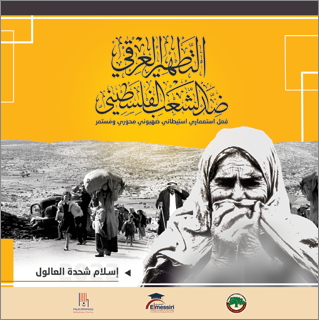Al-Zaytouna Centre for Studies and Consultations published a new book in Arabic entitled “The Ethnic Cleansing of the Palestinian People: An Ongoing Pivotal Colonial Settlement Zionist Act,” by Islam Elaloul. The 386-book was published in collaboration with PALM Strategic Initiative Centre–Malaysia and Elmessiri Academy for Research and Studies.
The book was presented by Dr. Nihad Muhammad Sheikh Khalil, an academic and lecturer at the Islamic University of Gaza, Department of History. He wrote that the youth’s contribution to the major narratives of the Palestinian issue gives hope, particularly in the midst of frustration lived by most Palestinians, and the pressures and challenges imposed by Israel.
Ethnic cleansing does not mean the annihilation of an entire people, but rather the use of systematic military and bureaucratic violence in order to reduce the number of Palestinians as much as possible within the Palestinian territories. In Nakbah (1948) and Naksah (1967), the Israeli occupation committed the most violent forms of ethnic cleansing against the Palestinian people, and it is still ongoing. This has led to the displacement of nearly half of the total Palestinian people, who were dispersed in refugee camps and in various parts of the world.
|
>> Click here to download: |
The first chapter of the book “A conceptual introduction to colonialism and ethnic cleansing in the Palestinian context” discusses the concept of colonialism in general, describes the colonial situation in Palestine and the position of international law on it. It explains the concept of ethnic cleansing in the Palestinian context.
Chapter two, “Ethnic cleansing against the Palestinians during the establishment of the occupying state 1947–1949,” discusses the Partition Resolution 181, issued by the United Nations General Assembly in 1947, stipulating the division of Palestine into two states, one for the Palestinians and the other for Jews. It describes the accompanying campaigns of ethnic cleansing during November 1947–April 1948. It also discusses Plan Dalet (Plan D) that was put by the Zionist forces to ethnically cleanse Palestine during the period 1/4/1948–14/5/1949. It called for expanding the “Jewish state” beyond the borders of the partition, by blowing up, burning and destroying Arab villages and expelling the Palestinians outside the borders, i.e., obtaining a “Jewish state” on the largest area of land and with the least number of Palestinians. This chapter also discusses the 1948 war, the declaration of the establishment of the “Jewish state” on 14/5/1948, the looting and theft of hundreds of Palestinian cities and villages and the more than thirty massacres that targeted the Palestinian people.
Chapter three, “Ethnic cleansing during the official phase of Zionist terrorism ‘state terrorism’ 1949–1967,” discusses the Zionist claim of the purity of its weapons from the crime of ethnic cleansing. It also talks about the Judaization of the cultural and geographical map of Palestine, through the Judaization of stolen Palestinian property, wiping out Palestinian villages, writing false history of Israel, and Judaizing the names of Palestinian landmarks and geographical locations. The chapter also deals with the Zionist military rule over the Palestinians of the 1948 occupied territories, and the practices of ethnic cleansing during 1948–1966.
In chapter four, “Ethnic cleansing during the phase of Zionist expansion since 1967–…,” the author discusses the ethnic cleansing during the June 1967 war, the beginning of the Israeli occupation of the West Bank and Gaza Strip, and ethnic cleansing against Palestinians during 1968–1993, and after the “peace” agreements.
The book includes also a case study entitled “Ethnic Cleansing of Jerusalemites in the Palestinian Communities Behind the Wall,” and another entitled, “Under Security Cover: Carrying Out Continuous Ethnic Cleansing Against the Palestinians: Citizens of Downtown Hebron.”
This book clarifies the aggressive nature of this occupation, diagnoses it, explores its dangers, and proves its inability to peaceful coexistence and its constant tendency to more extremism and brutality. The book explains all of these facts in an easy language, enabling every one to understand, especially that it uses illustrative diagrams, archive photos and maps to clarify and simplify the ideas.










Leave A Comment